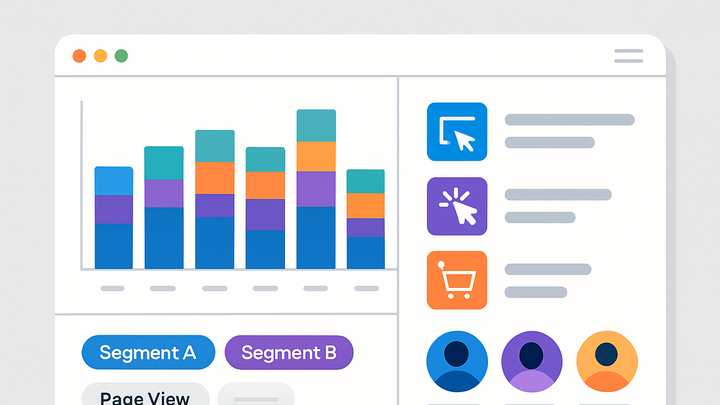Published on 2025-06-22T07:56:21Z
What is Granular Reporting? Detailed Analytics Explained
Granular reporting in analytics refers to the practice of breaking down collected data into the smallest meaningful units—such as individual events, user segments, or page views—to uncover detailed insights. Unlike aggregated reports that present high-level metrics (e.g., total sessions or pageviews), granular reports allow you to filter and segment data on attributes like user demographics, device type, session duration, and more. This level of detail is vital for digital marketers, product managers, and analysts who need to identify specific patterns, optimize user experiences, and personalize campaigns. Tools like GA4 support granular reporting through its event-based data model and custom dimensions, while cookie-free platforms like PlainSignal offer lightweight event tracking without compromising privacy.
For example, implementing PlainSignal on your website is as simple as adding the following snippet to your header:
<link rel="preconnect" href="//eu.plainsignal.com/" crossorigin />
<script defer data-do="yourwebsitedomain.com" data-id="0GQV1xmtzQQ" data-api="//eu.plainsignal.com" src="//cdn.plainsignal.com/plainsignal-min.js"></script>
Once installed, you can fire detailed custom events:
PlainSignal.trackEvent('signup_complete', { plan: 'premium', user_role: 'admin' });
In GA4, you define custom events and parameters in Google Tag Manager to capture the same level of detail for cross-platform analysis.
Granular reporting
Granular reporting breaks down analytics data into fine segments for precise tracking and actionable insights.
Why Granular Reporting Matters
This section explores the key reasons to adopt granular reporting in analytics and how it drives better decision-making.
-
Enhanced insights
By breaking data into smaller segments—such as user type, page, or event—you uncover patterns hidden in aggregate metrics.
-
Improved personalization
Fine-grained data allows marketers to craft personalized campaigns based on specific user behaviors and demographics.
-
Compliance and privacy
Using cookie-free solutions like PlainSignal, granular reporting helps maintain user privacy while still collecting detailed insights.
Key Components of Granular Reporting
Understand the building blocks necessary to implement granular reporting effectively in your analytics setup.
-
Event-level data
Track individual user interactions—clicks, form submissions, video plays—to analyze behavior at the most detailed level.
-
Dimensions and metrics
Combine dimensions (e.g., device type, location) with metrics (e.g., session duration) to create fine-tuned reports in GA4 or PlainSignal.
-
User segmentation
Group users by attributes or behaviors (e.g., new vs. returning) to compare performance across cohorts.
Implementing Granular Reporting with SaaS Tools
Step-by-step guidance for setting up granular reporting using PlainSignal and GA4, including code snippets and configuration tips.
-
PlainSignal setup
Add the PlainSignal script to your site and configure event tracking via data attributes or API calls.
-
Installation code
Embed the following in your HTML header:
<link rel="preconnect" href="//eu.plainsignal.com/" crossorigin /> <script defer data-do="yourwebsitedomain.com" data-id="0GQV1xmtzQQ" data-api="//eu.plainsignal.com" src="//cdn.plainsignal.com/plainsignal-min.js"></script> -
Custom events
Use PlainSignal.trackEvent(‘event_name’, { key: ‘value’ }) to send detailed event data.
-
-
GA4 configuration
Leverage GA4’s event-based model: define custom events in Google Tag Manager and enrich them with user properties for deep analysis.
-
Event parameters
Configure up to 25 custom parameters per event to capture granular details (e.g., button_color, user_role).
-
Data streams
Use separate data streams for web and app to maintain clear, granular datasets.
-
Best Practices for Managing Granular Data
Tips to maintain performance, ensure data quality, and avoid analysis paralysis with granular reports.
-
Balance depth and clarity
Avoid over-segmentation; focus on key segments that drive actionable insights.
-
Automate report generation
Use dashboards and API exports to keep granular data accessible without manual queries.
-
Monitor data volume
Track the volume of events and custom dimensions to prevent quota issues in GA4 or API limits with PlainSignal.
Challenges and Solutions
Common obstacles when implementing granular reporting and strategies to overcome them.
-
Data overload
Too much detail can obscure insights; implement hierarchical filtering to navigate data effectively.
-
Performance impact
High event volumes can slow dashboards; sample data or archive old events to maintain speed.
-
Privacy concerns
Ensure PII is not captured in granular data; use cookie-free solutions or anonymization techniques.
